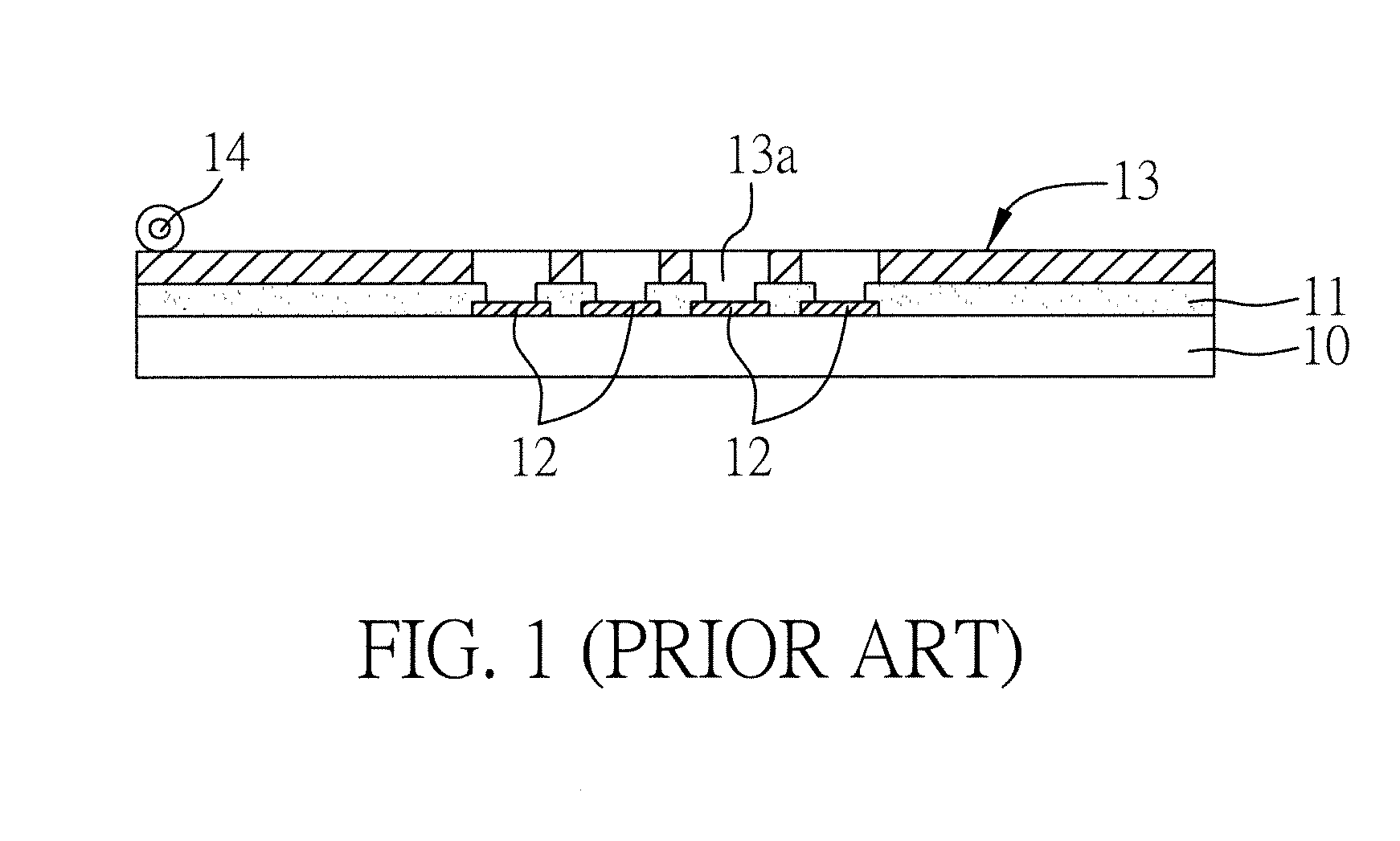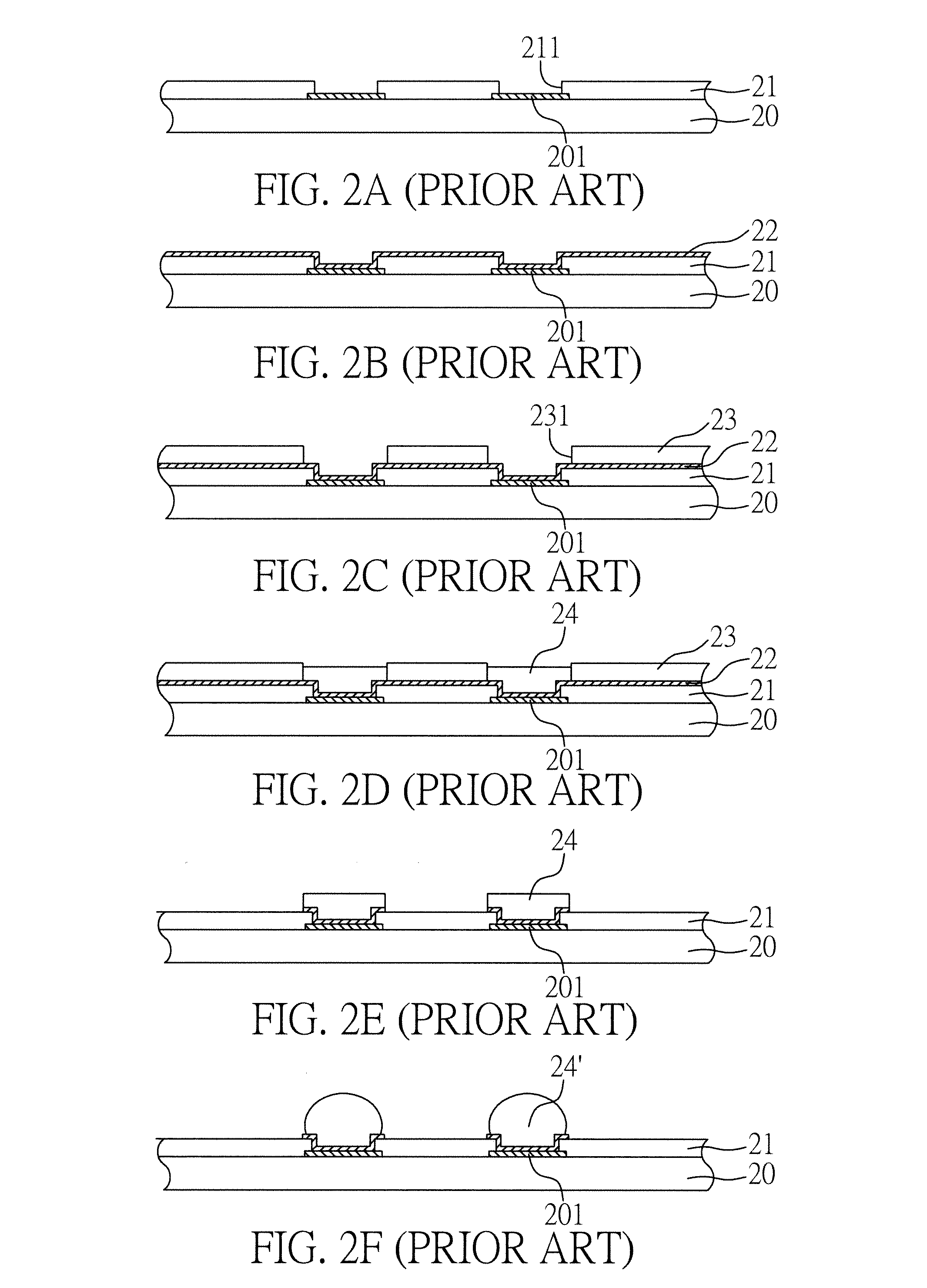Method for Fabricating Circuit Board with Conductive Structure
a technology of conductive structure and circuit board, which is applied in the direction of printed circuit aspects, conductive pattern formation, printed circuit components, etc., can solve the problems of low yield of stencil printing technology, circuit board with high circuit density experiences significant difficulty in allocation and adhesion, and achieves low connectivity. high
- Summary
- Abstract
- Description
- Claims
- Application Information
AI Technical Summary
Benefits of technology
Problems solved by technology
Method used
Image
Examples
first embodiment
The First Embodiment
[0054]Referring to FIGS. 3A to 3F, cross-sectional views are depicted of a proposal for a method for fabricating a circuit board with an electrically connecting structure. Note that all the drawings are simplified and only the basic construction of the present invention is shown. Therefore, elements appearing in the figures for the present invention are not drawn as to real numbers, shapes, and sizes as used in actual practice. The numbers, shapes and sizes are variable design matters, and the arrangements of the elements can be more complicated.
[0055]First of all, referring to FIG. 3A, a circuit board 30 is provided with a first surface 30a and a second surface 30b, and the first surface 30a has a plurality of differently sized first electrically connecting pads 301 and second electrically connecting pads 302, while the second surface 30b has a plurality of third electrically connecting pads 303. Additionally, first and second insulating protective layers 304a, ...
second embodiment
The Second Embodiment
[0065]Referring to FIGS. 4A to 4F, another fabricating method is provided for the present invention. The main difference from the foregoing embodiment is that the first and second electrically connecting structures are formed respectively on the surfaces and in the openings of the first and second insulating protective layer. Then, the second electrically connecting structures are formed by the stencil printing on the first conductive layer of the surface of the second electrically connecting pads. The detailed description is as followings.
[0066]Firstly, referring to FIG. 4A, a circuit board 30 is provided with a first surface 30a and a second surface 30b, and the first surface 30a has a plurality of first electrically connecting pads 301 and a second electrically connecting pads 302, while the second surface 30b has a plurality of third electrically connecting pads 303. Moreover, first and second insulating protective layers 304a, 304b are formed on the first a...
third embodiment
The Third Embodiment
[0073]Referring to FIGS. 5A to 5D, yet another fabricating method for the present invention is depicted. The difference from the foregoing embodiment is that the first and second resist layers are formed on the first and second conductive layers by laminating. The detailed descriptions are as followings.
[0074]Firstly, referring to FIG. 5A, first and second conductive layers 31a, 31b are formed on the surface of the first and second insulating protective layers 304a, 304b and in the openings 305a, 305b of the first and second insulating protective layers 304a, 304b on the circuit board 30. The first and second conductive layers 31a, 31b are electrically connected to the first, second, and third electrically connecting pads 301, 302, 303. Then, first and second resist layers 32a, 32b are formed on the first and second conductive layers 31a, 31b by laminating.
[0075]Secondly, referring to FIG. 5B, a plurality of openings 321a, 321b corresponding to the first and thir...
PUM
| Property | Measurement | Unit |
|---|---|---|
| Electrical conductor | aaaaa | aaaaa |
Abstract
Description
Claims
Application Information
 Login to View More
Login to View More - R&D
- Intellectual Property
- Life Sciences
- Materials
- Tech Scout
- Unparalleled Data Quality
- Higher Quality Content
- 60% Fewer Hallucinations
Browse by: Latest US Patents, China's latest patents, Technical Efficacy Thesaurus, Application Domain, Technology Topic, Popular Technical Reports.
© 2025 PatSnap. All rights reserved.Legal|Privacy policy|Modern Slavery Act Transparency Statement|Sitemap|About US| Contact US: help@patsnap.com



